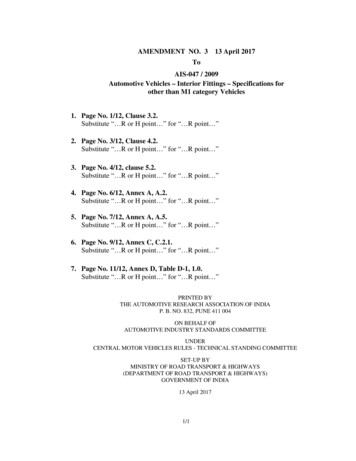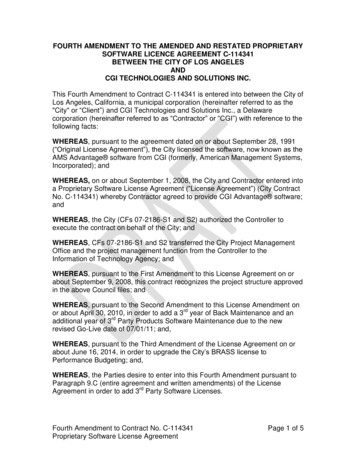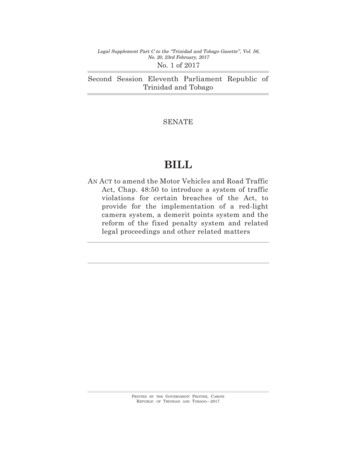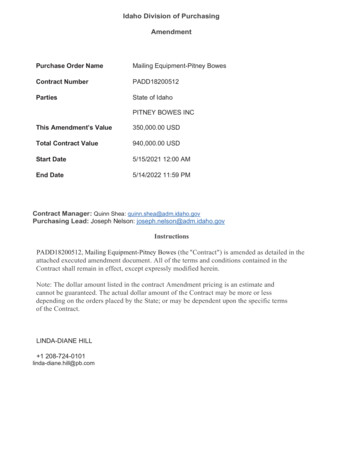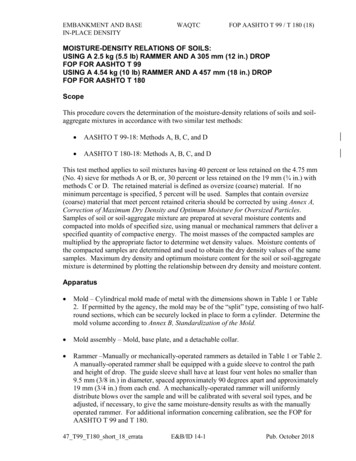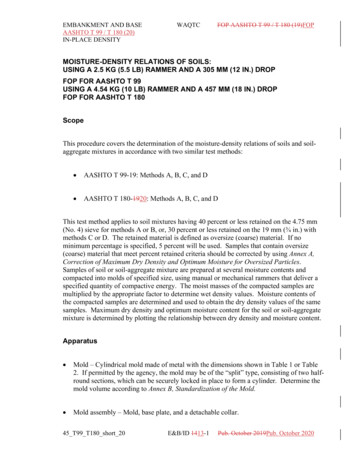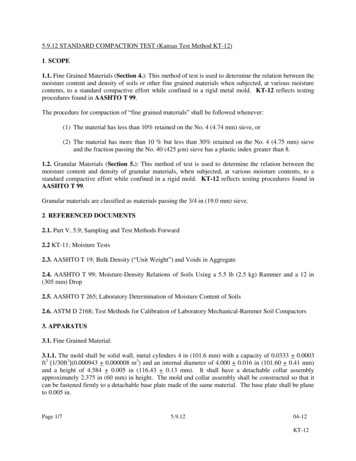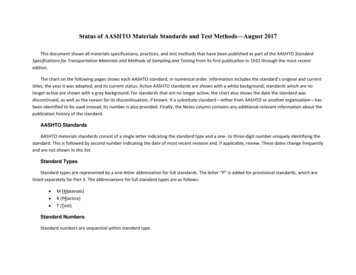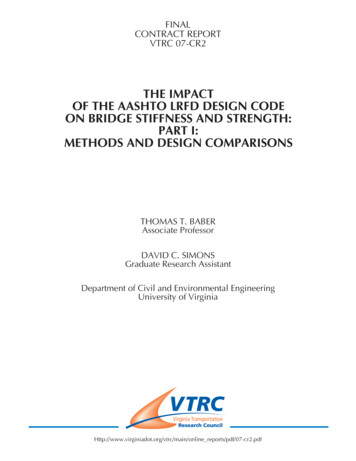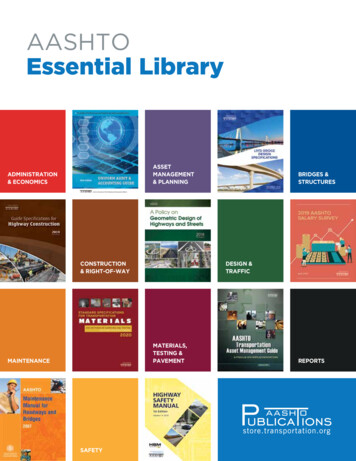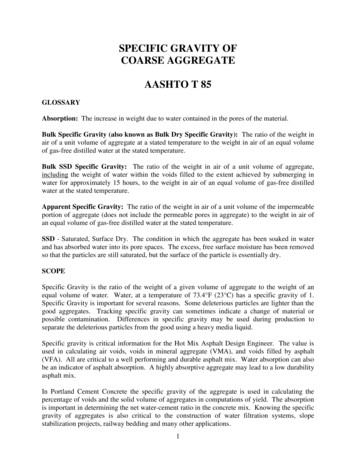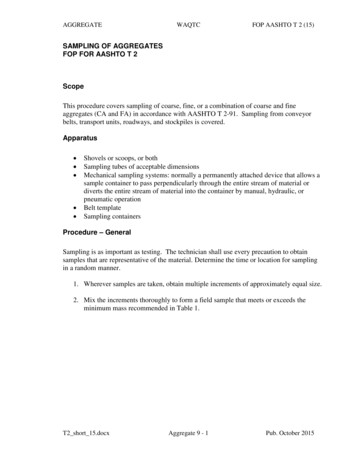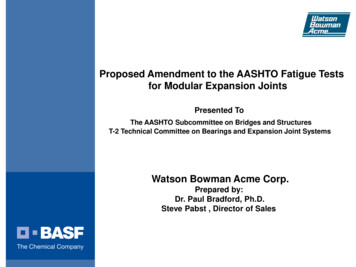
Transcription
Proposed Amendment to the AASHTO Fatigue Testsfor Modular Expansion JointsPresented ToThe AASHTO Subcommittee on Bridges and StructuresT-2 Technical Committee on Bearings and Expansion Joint SystemsWatson Bowman Acme Corp.Prepared by:Dr. Paul Bradford, Ph.D.Steve Pabst , Director of Sales
DISCUSSION OVERVIEW1. CURRENT AND ACCEPTED LIFE CYCLE FATIGUE TEST CRITERIA2. FULL SCALE TESTING OF MODULAR JOINT SYSTEM SPECIMEN3. SUGGESTIONS FOR TESTING OF MODULAR JOINT SYSTEMCOMPONENTS2
AASHTO LRFD Construction SpecificationsSection 19 Fatigue Test: Current full scale test protocol System fatigue testing for steel (metal) component connections. Joint placed on a 20% slope to produce a 20% horizontal load. Strains measured at strain gage locations, nominal stress calculated at the details ofinterest (e.g. connections). Higher than design loads are applied and cycled until the connection fails, or until the test isterminated. Number of cycles at failure (N) and stress (S) charted, 10 samples are required to identifythe design fatigue category (usually C or B).3
Illustration of 20% gradient load application toSimulate horizontal and vertical loads4
The current test protocol has worked well.However there are shortcomings 1.Owner/Specifier Feedback – Test stresses are much higher than design,many connection failures occur at less than 1 million cycles. As anillustration, how do we know that even if the stresses are much lower that theconnection won’t fail at an elevated test of up to 50 million cycles”2.Manufacturer Observations – Current life cycle fatigue test protocol suggestscomponent revisions or detail improvements will subject manufacturers toonerous costs associated with full scale system re-testing.5
Proposed modification to current standard1. Maintain current requirements of full scalemanufacturer system testing:“No change or revision to current full scale fatigue testingspecification requirements.”2. Addenda for component redesign or modifications:“If a system has successfully passed full scale system fatiguetesting. Manufacturer component design modifications maybe supported and meet current requirements withsupplementary subsystem or component only fatigue tests.”6
Illustration of design revisions eligiblefor component testing Examples: Eliminating a weld by using a single piece yoke Changing the weld process Changes in geometry of steel components Using standard fatigue connection details already covered by AASHTO Project specific requirements7
An example of recommended test protocol for“secondary” component redesignSample size per component: 4Number of cycles: 7 millionWHY 7 MILLION CYCLES? The number of 7 million cycles is based upon the assumption thatconnections will achieve at least a category D rated connection. Henceevery test run will exceed the theoretical infinite life cycle count forCategories B, B’, C, C’, and D per AASHTO Figure C6.6.1.2.5-1. Theapproach is different in that no attempt is made to establish an SN curve,rather the CAFT is met. The number of cycles is large, but because it isintended for all tests to exceed the run out cycle count, the number ofsamples tested is reduced from 10 to 4.8
S/N Test SpacesSystem testspaceSubsystem testspace9
Suggested Provisions for Component Testing Tests are to be designed such that the geometry of the component and near the component isthe same as that being used on the project Specimens are to be full size Geometry away from the component being tested may be modified to assist with test fixturing Loads shall produce similar stress ranges at the detail as expected in the field10
In Summary Current AASHTO specifications do not address the situation ofvariations to connection details on previously tested systems. WBA proposes to append the current specifications with a sectionallowing for subsystem testing. The subsystem test approach is little bit different approach, highcycle counts at service level loads that more closely represent actualloads. This is in contrast to the system tests that incorporate lowercycle counts with higher loads. It is anticipated that lower loads and simpler fixturing allow for highfrequency testing, resulting in reduced test time and costs.11
T-2 Technical Committee on Bearings and Expansion Joint Systems . 2 DISCUSSION OVERVIEW 1. CURRENT AND ACCEPTED LIFE CYCLE FATIGUE TEST CRITERIA 2. FULL SCALE TESTING OF MODULAR JOINT SYSTEM SPECIMEN 3. SUGGESTIONS FOR TESTING OF MODULAR JOINT SYSTEM COMPONENTS . 3 AASHTO LRFD Construction Specifications Section 19 Fatigue Test:
